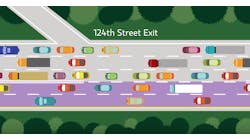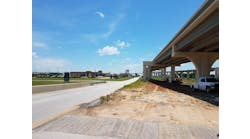"AASHTO has recommended and approved the use of soft-metric in all highway construction," Walther told ROADS & BRIDGES. "ASTM [also] has developed the soft-metric specifications as the current rebar spec." With the use of soft-metricated rebar, the inch-pound bar sizes will eventually become nonexistent.
The initial conversion method for reinforcing steel was hard metrication, which reduced the existing 11 inch-pound bar sizes to eight new hard-metricated rebar sizes. "Everyone thought that it would be a nice opportunity to change the old existing system, inch-pounds, to a hard metric system, which eliminated three of the bars," Walther said.
The move towards metrication of reinforcing steel began with the 1975 Metric Conversion Act and was further accelerated by the 1988 Omnibus Trade and Competitiveness Act.
The metrication program was to be accomplished on a "voluntary" basis, but according to Walther, no one in the private or public sector used them because they would have to change their designs to accommodate the eight new bar sizes.
In 1988, the Omnibus Trade and Competitiveness Act was passed, stating that in order to get federal funding for federal projects, metric products must be used. Because using the hard-metric rebar sizes was not required in the private-sector construction market, which represented 70% of the total construction market, this market stayed with the inch-pound bar sizes. With 30% of the federally funded market using the newly specified eight bar sizes, and the remaining 70% of the market staying with the 11 inch-bar sizes, a new problem was created--19 bar sizes.
The reinforcing steel industry conducted an in-depth analysis of the economic impact on the construction industry of having to carry two complete inventory systems. The analysis determined that this dual inventory system would cost the end consumer $300 million per year.
Their solution to the problem, according to Walther, was to implement soft-metricated reinforcing steel. By using this approach to metrication, the existing 11 inch-pound sizes physically remain unchanged.
The only necessary change would then be to develop new soft-metric names for those existing rebars, giving the metric equivalent to the old bar sizes. The inch-pound size is the name of the bar expressed in eighths of an inch in diameter. A #6 bar is 6-in. diam. In the metric system, the bars are renamed, using millimeters. A #10 metric bar is 10-mm diam. Thus, a #6 inch-pound bar size is now a #10 soft-metricated bar size.
"In essence, we're staying with the 11 bar sizes that we always had, which are still being produced, but they have a new name," Walther said." We've eliminated the need for the eight new hard-metric sizes, they don't exist anymore, so there's not the increase of $300 million per year to the industry, and ultimately, to the consumer."
By federal law using soft-metricated rebar is already required. For federal-funded highway construction it started in September 1996 and for the General Service Administration federally funded construction started in January 1994. November 28, 1995 President Clinton signed a bill that extended the requirement date to the year 2000.
"We started in 1975, everyone embraced it, all in good faith--it was a noble experiment that the specs were changed to accommodate new hard-metric sizes, but no one wanted to use them because it would cost them money to change all of their design standards and all of the things that they were used to all of these years."


